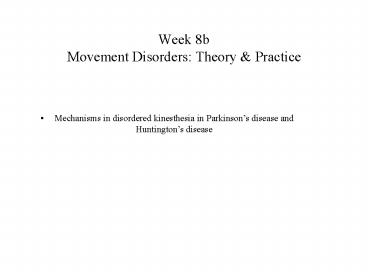Week 8b Movement Disorders: Theory PowerPoint PPT Presentation
1 / 13
Title: Week 8b Movement Disorders: Theory
1
Week 8bMovement Disorders Theory Practice
- Mechanisms in disordered kinesthesia in
Parkinsons disease and Huntingtons disease
2
Tendon vibration and kinesthesia
- Use non-vibrated arm to report perceived arm
position of vibrated arm. - Fiber sensitivity
- Ia afferents gt II afferents gt Ib afferents ? 0
- Firing pattern of some receptors becomes
locked to vibration pattern while other
receptors are unaffected - Effect is frequency dependent
- Effect is also dependent on timing of vibration
onset
(Calvin-Figuiere et al., 1999)
3
Frequency velocity-dependent illusion in
healthy normal subjects
overshoot
20 Hz
30 Hz
undershoot
40 Hz
Illusion appears to be related to difference
between vibration-evoked and movement-evoked
activity in muscle spindle afferents (Cordo et
al., 1995)
4
Effects of vibration timing and joint velocity
40 Hz
lt onset of elbow rotation
during elbow rotation
before and during elbow rotation
5
Kinesthesia in Parkinsons disease
ratio 1 means no illusion due to tendon
vibration ratio lt 1 means movement undershoot
- Vibrated and non-vibrated movements performed
with visual feedback occluded - PD patients showed reduced or absent movement
illusions as compared to controls (Rickards and
Cody, 1997)
6
Distorted kinesthesia in most severe side in PD
- Unilateral PD patients showed significantly
lower magnitude undershoot for the more affected
side compared to the less affected side - PDs also showed differences between on and
off stages
7
Kinesthetic reaction time
- PD patients and controls given 4 subtests of the
Sensory Integration and Praxis Test (kinesthesia,
graphesthesia, finger identification, and
localization of tactile stimuli) - PD patients display significantly greater
constant error when performing visually occluded
target-to-target finger movements (Kinesthesia
Subtest) - Patients did not display impairments in the
other 3 subtests (Jobst et al., 1997)
- PD Patients had slower Kinesthetic RT compared
to elderly controls (Evarts et al., 1981)
8
Brain imaging under tendon vibration in PD and HD
- Abnormal cortical and subcortical activation and
deactivations detected by PET during passive
sensory (tendon vibration) stimulation in PD and
HD (Boecker et al., 1999) - Summary
- Decreased activity in contralateral S1-M1
(sensorimotor cortex), S2, posterior cingulate,
GP, VL, and bilateral prefrontal cortex. - Increased activity in ipsilateral areas of S1
and S2 may reflect - altered striato-thalamo-cortical gating of
sensory impulses (lack of selectivity) - compensatory recruitment of associative sensory
areas in the presence of basal ganglia dysfunction
9
Contralateral S1/S2, GP and VL activated during
tendon vibration in healthy age-matched controls
10
Decrease in vibration-induced brain activations
in S1/S2 and basal ganglia in PD and HD with
respect to controls
11
Brain areas activated in the controls during
vibration
12
Brain areas activated by vibration in PD and HD
Note abnormally recruited ipsilateral thalamus,
inferior parietal lobe and S2 compensation, loss
of balance, disrupted cortical dopamine levels?
13
Effects of PD and HD

